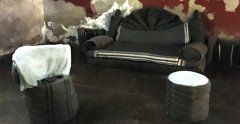Human creativity can reach to its peak under the most difficult conditions. Sometimes we witness unique art pieces or productions with an artistic value which are created at a concentration camp, where hundreds of thousands of people were massacred, or at a prison where the prisoners who were living under tough conditions were being tortured. The different forms of art which emerge under such difficult circumstances are robust indications of the tremendous efforts to develop spiritual resistance and celebrate the life against all the odds.
One of the unique forms of art emerged in Johannesburg's notorious Number Four prison, located in the former prison and military fort complex in Johannesburg. Number Four today is part of the ‘Constitution Hill’ which is a living museum, a memory site housing South Africa’s Constitutional Court. Having a century long history, the prison complex housed a several types of prisoners over the course of its lifespan. Other than criminal convicts, during the Apartheid regime political prisoners and Apartheid regime violators were stationed in this prison complex. A unique form of art named as ‘Blanket Art’ was born in the Prison Number Four. The prisoners used the blankets to create a range of designs and objects. They created even living rooms to please the leaders of the gangs by using blankets. Over the course of the time the blanket art became a form of spiritual resistance and even some of the guards were so impressed by it, they even started competitions among the artworks. The winner would receive extra food or a piece of cake. Today one part of the museum exhibition consists of the impressive specimens of ‘Blanket Art’.









